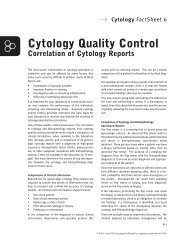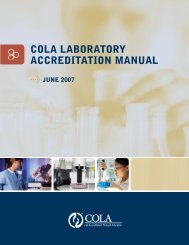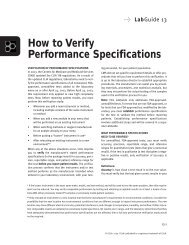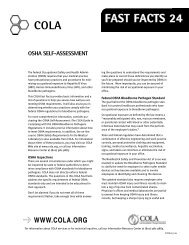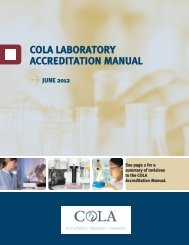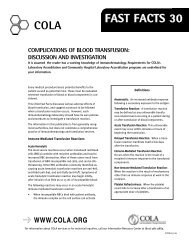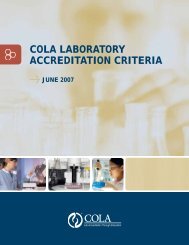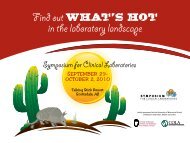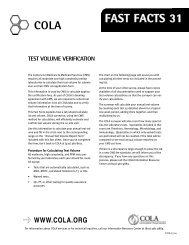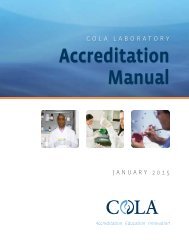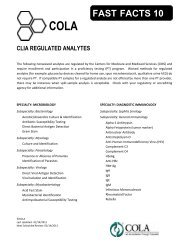#06-5558 Accrd Manual V7 - COLA
#06-5558 Accrd Manual V7 - COLA
#06-5558 Accrd Manual V7 - COLA
- No tags were found...
You also want an ePaper? Increase the reach of your titles
YUMPU automatically turns print PDFs into web optimized ePapers that Google loves.
IMMUNOHEMATOLOGY & TRANSFUSION SERVICESTS 14 RAre written procedures in place permitting immediate corrective action to occur 24 hours a day in response toan audible alarm?TS 15 RAre alarm checks performed and documented that verify the temperature at which the audible refrigerationalarm will sound?TS 16 RAre explanations for temperature deviations documented?TS 17 EAre all blood and blood components stored and shipped at the required temperatures according to applicableFDA guidelines at 21 CFR 610?Guidelines specify:• Whole blood and red blood cell components and liquid plasma – stored between 1-6 degrees C andshipped at 1-10 degrees C.• Frozen RBC’s – stored at minus 65 degrees C.• Fresh frozen plasma(FFP) – stored and shipped at -18 degrees C. If needed for coagulation factors, shouldtransfuse within 24 hours.. Thaw at 30-37 degrees C. and kept at 1-6 degrees C. in the interim prior totransfusion.• Cryoprecipitated Antihemophiliac Factor Human (AFH) – stored and shipped at -18 degrees C. If neededfor factor VIII, should transfuse within 6 hours. Thaw at 30-37 degrees C. and held at room temperature inthe interim.• Platelets and Platelet-rich plasma – stored and shipped at 20-24 degrees C. or 1-6 degrees C. Blood orplasma should be held at 20-24 degrees C. prior to separation of platelets that should be done within4 hours of collection. Once separated, they should be continuously maintained at either 1-6 degrees C. or20-24 degrees C. If stored at 20-24 degrees C., a continuous gentle agitation (or rocking) must be maintainedthroughout the storage period. Agitation is optional at 1-6 degrees C.TS 18 RAre special areas defined for the storage of blood and blood components that avoid contamination or exposureto hazardous materials?TS 19 RAre areas clearly designated for the storage of available, crossmatched, quarantined, autologous and directedunits?TS 20 RIs the maintenance of the proper storage temperatures of blood or blood components assured when units areheld outside of the laboratory’s control (E.g. ICU, ER, or OR)?This requires a method of assuring that once units are released for transfusion they are used promptly orstored appropriately, then returned to the lab in a timely fashion thus suitable for reissue.TS 21 RDo the containers used for the transport of blood and blood components assure maintenance of the desiredtemperatures during shipping?Record periodic checks performed to verify their capacity to maintain required temperatures.TS 22 RAre all blood and blood components promptly disposed of after the product’s expiration date has passed andretention for further testing is not required and is there a record of disposal?66. . . . . . . . . . . . . . . . . . . . . . . . . . . . . . . . . . . . . . . . . . . . . . . . . . . . . . . . . . . . . . . . . . . . . . . . . . . . . . . . . . . . . . . . . . . . . . . . . . . . . . . . . . . . . . . . . . . . . . . . .FOR MORE INFORMATION CONTACT <strong>COLA</strong> PHONE 800.981.9883 | FAX 410.381.8611 | ON-LINE www.cola.org




